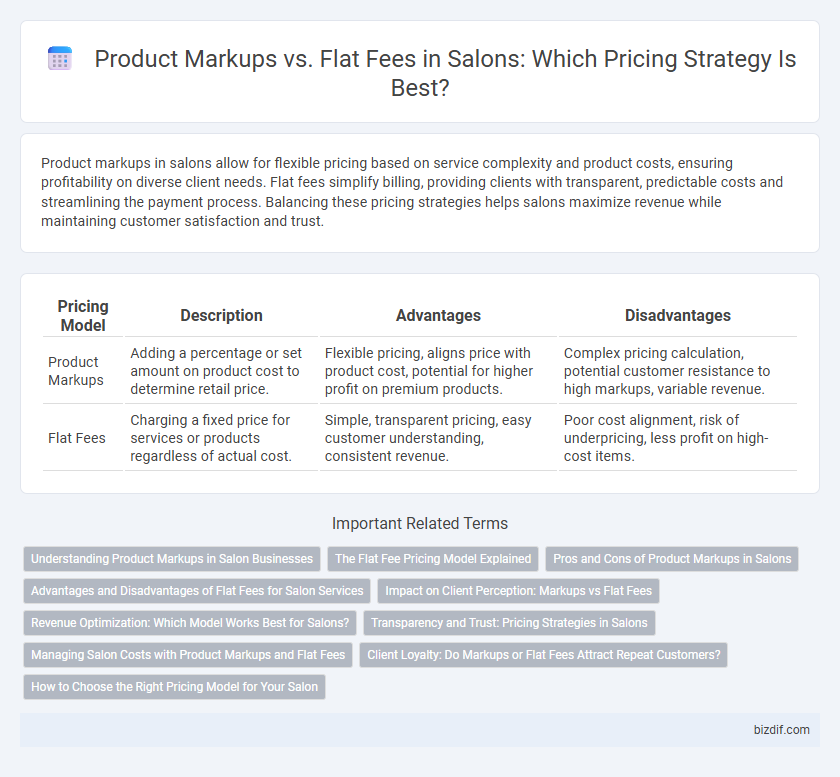Product markups in salons allow for flexible pricing based on service complexity and product costs, ensuring profitability on diverse client needs. Flat fees simplify billing, providing clients with transparent, predictable costs and streamlining the payment process. Balancing these pricing strategies helps salons maximize revenue while maintaining customer satisfaction and trust.
Table of Comparison
| Pricing Model | Description | Advantages | Disadvantages |
|---|---|---|---|
| Product Markups | Adding a percentage or set amount on product cost to determine retail price. | Flexible pricing, aligns price with product cost, potential for higher profit on premium products. | Complex pricing calculation, potential customer resistance to high markups, variable revenue. |
| Flat Fees | Charging a fixed price for services or products regardless of actual cost. | Simple, transparent pricing, easy customer understanding, consistent revenue. | Poor cost alignment, risk of underpricing, less profit on high-cost items. |
Understanding Product Markups in Salon Businesses
Product markups in salon businesses refer to the percentage added to the wholesale cost of retail products to determine the selling price, directly impacting profit margins. Understanding product markups helps salon owners balance competitive pricing with maximizing revenue, often ranging between 50% to 100% depending on product type and brand. Flat fees, by contrast, are fixed charges for services or products that may not reflect cost variations, making product markups a more flexible and strategic pricing method for inventory management and profitability analysis.
The Flat Fee Pricing Model Explained
The flat fee pricing model in salons simplifies billing by charging a fixed rate for specific services, eliminating confusion over variable product markups. This approach enhances transparency for clients, who pay a consistent amount regardless of the cost of products used during their appointment. Salons adopting flat fees can improve customer trust and streamline staff training by standardizing service costs.
Pros and Cons of Product Markups in Salons
Product markups in salons offer flexibility by allowing prices to reflect individual product costs and demand, potentially increasing profit margins on high-end items. However, they can lead to customer dissatisfaction due to inconsistent pricing and may discourage clients from purchasing retail products. Salons using product markups must balance profitability with transparent pricing strategies to maintain client trust and loyalty.
Advantages and Disadvantages of Flat Fees for Salon Services
Flat fees for salon services offer pricing transparency, enabling clients to know the exact cost upfront, which can enhance customer trust and simplify budgeting. This model reduces complexity in billing and eases staff training as employees charge a fixed amount regardless of service variations. However, flat fees may limit revenue potential during high-demand services and can lead to undercharging for time-intensive treatments, potentially impacting salon profitability.
Impact on Client Perception: Markups vs Flat Fees
Product markups in salons can create a perception of inflated costs, potentially undermining client trust, especially when price transparency is lacking. Flat fees offer clients clarity and predictability, fostering a sense of fairness and straightforwardness that enhances satisfaction. Clear communication about pricing strategies helps manage expectations and reinforces the salon's commitment to value.
Revenue Optimization: Which Model Works Best for Salons?
Product markups offer salons flexible revenue growth by adjusting prices based on inventory cost fluctuations and demand, maximizing profit margins on retail sales. Flat fees provide predictable income streams through fixed service charges, simplifying budgeting and client pricing transparency. Optimizing revenue often involves a hybrid approach, leveraging markups for retail and flat fees for services to balance profitability and client satisfaction.
Transparency and Trust: Pricing Strategies in Salons
Transparent pricing in salons enhances customer trust and satisfaction by clearly distinguishing between product markups and flat fees. Product markups incentivize quality product use but require honest communication to avoid perceived overcharging. Flat fees offer straightforward pricing, simplifying expectations and fostering a transparent salon-client relationship.
Managing Salon Costs with Product Markups and Flat Fees
Managing salon costs effectively involves balancing product markups and flat fees to maximize profitability while maintaining customer satisfaction. Product markups allow salons to adjust prices based on wholesale costs and demand, ensuring flexible revenue streams, whereas flat fees provide predictable income and simplified billing for services such as haircuts or treatments. Implementing a strategic combination of both pricing models helps salons control expenses, optimize profit margins, and offer transparent pricing to clients.
Client Loyalty: Do Markups or Flat Fees Attract Repeat Customers?
Salon client loyalty often hinges on transparent and predictable pricing structures; flat fees tend to foster trust by providing clear costs upfront, reducing surprise charges that can deter repeat visits. Product markups, while potentially increasing revenue per purchase, may lead clients to feel overcharged, risking dissatisfaction and decreased return rates. Studies in salon management suggest flat fees correlate more strongly with sustained client retention and positive word-of-mouth referrals.
How to Choose the Right Pricing Model for Your Salon
Choosing the right pricing model for your salon depends on client preferences and service diversity; product markups increase revenue through retail sales of haircare and beauty products but require careful pricing to avoid deterring customers. Flat fees ensure consistent income per service, simplifying billing and improving client satisfaction by providing transparent costs. Analyze customer buying behavior, product quality, and service complexity to select a pricing strategy that maximizes profitability and enhances salon experience.
Product markups vs Flat fees Infographic

 bizdif.com
bizdif.com